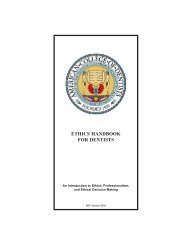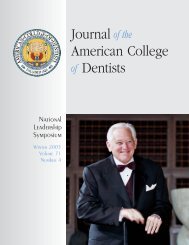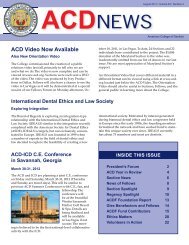Journal of the American College of Dentists
Journal of the American College of Dentists
Journal of the American College of Dentists
You also want an ePaper? Increase the reach of your titles
YUMPU automatically turns print PDFs into web optimized ePapers that Google loves.
Manuscript<br />
for students to increase <strong>the</strong>ir competitiveness<br />
by building stronger foundations<br />
in <strong>the</strong> biological sciences which prepares<br />
<strong>the</strong>m for <strong>the</strong> challenging dental<br />
school curriculum.<br />
Retaining and graduating URM<br />
students is just as important as enrolling<br />
<strong>the</strong>m. At <strong>the</strong> local, regional, and national<br />
levels, discussions about increasing <strong>the</strong><br />
diversity <strong>of</strong> dental schools inevitably<br />
include <strong>the</strong> questions: “How well do URM<br />
students perform once admitted?” “Are<br />
<strong>the</strong>y retained?” and “Do <strong>the</strong>y graduate?”<br />
The <strong>American</strong> Dental Association collects<br />
national data on <strong>the</strong> numbers <strong>of</strong> dental<br />
school graduates, including URM graduates.<br />
However, <strong>the</strong>re is no national data<br />
on retention rates <strong>of</strong> URM students.<br />
Although it is only one school’s story,<br />
<strong>the</strong> data presented in this paper show<br />
that, once admitted, <strong>the</strong> retention rate<br />
<strong>of</strong> URM students can be very high and<br />
comparable to that <strong>of</strong> all dental students.<br />
The URM students enrolled in TAMHSC-<br />
BCD’s DDS program perform across<br />
<strong>the</strong> same range <strong>of</strong> performance as <strong>the</strong><br />
general population <strong>of</strong> <strong>the</strong> class. There<br />
are URM students in <strong>the</strong> top quartile,<br />
middle range, and bottom quartile, just<br />
like <strong>the</strong> o<strong>the</strong>r demographic groups.<br />
Since TAMHSC-BCD is enrolling more<br />
students who come from disadvantaged<br />
backgrounds and URM students are more<br />
likely to be from <strong>the</strong>se backgrounds,<br />
slightly more URM students need additional<br />
help than <strong>the</strong> non-minority<br />
students. But this is reasonable, since<br />
being disadvantaged by definition means<br />
<strong>the</strong> student may require more support<br />
to catch up to those who have had many<br />
advantages all along <strong>the</strong>ir academic<br />
careers. URM does not equate to “a<br />
retention problem.”<br />
The structure <strong>of</strong> TAMHSC-BCD’s<br />
retention program is unique due to <strong>the</strong><br />
wide array <strong>of</strong> services provided and <strong>the</strong><br />
number <strong>of</strong> faculty, administrators, and<br />
staff involved in <strong>the</strong> retention process.<br />
The Student Success Team represents<br />
multiple <strong>of</strong>fices including those <strong>of</strong><br />
Student Affairs, Academic Affairs,<br />
Recruitment & Admissions, and Student<br />
Development. This “team” approach<br />
facilitates a collaborative effort by key<br />
personnel who are intimately involved<br />
with students for different reasons and<br />
prevents any student from “falling<br />
through <strong>the</strong> cracks.”<br />
Peer tutors are trained by <strong>the</strong><br />
Educational Specialist to develop and<br />
enhance <strong>the</strong>ir teaching skills. Tutors<br />
are also paid by <strong>the</strong> college in order<br />
to hold <strong>the</strong>m to a high standard <strong>of</strong><br />
accountability. In addition, <strong>the</strong>y receive<br />
credit for a selective course for tutoring.<br />
All students are required to take at least<br />
two selective courses.<br />
TAMHSC-BCD pays for a prescribed<br />
number <strong>of</strong> pr<strong>of</strong>essional psychological<br />
counseling sessions for students.<br />
Therefore, students do not have to<br />
neglect receiving this service due to<br />
financial constraints.<br />
The five-year curriculum is an alternative<br />
for students who need additional<br />
time to successfully negotiate <strong>the</strong> firstyear<br />
dental curriculum. Students can<br />
choose <strong>the</strong> five-year program before<br />
matriculating into <strong>the</strong> college or <strong>the</strong>y<br />
can enter it once <strong>the</strong>y have are enrolled.<br />
This allows students <strong>the</strong> flexibility to<br />
make decision about <strong>the</strong> program at <strong>the</strong><br />
appropriate time. For <strong>the</strong> last several<br />
years, <strong>the</strong> retention rate <strong>of</strong> students in<br />
<strong>the</strong> five-year program has closely<br />
approximated 100%.<br />
The structure that <strong>the</strong> <strong>of</strong> Office <strong>of</strong><br />
Student Development has developed<br />
into one that has a long-standing<br />
relationship with many <strong>of</strong> <strong>the</strong> college’s<br />
dental students. Many <strong>of</strong> <strong>the</strong> URM<br />
students participated in one or more <strong>of</strong><br />
TAMHSC-BCD’s pre-dental programs.<br />
These students, <strong>the</strong>refore, have developed<br />
a sense <strong>of</strong> “belonging” at <strong>the</strong> college.<br />
The <strong>of</strong>fice serves as a place where students<br />
can get help from those that <strong>the</strong>y know<br />
and trust.<br />
How can TAMHSC-BCD’s retention<br />
program be enhanced? Table 2 shows<br />
that minimal students still need to pass<br />
Part II <strong>of</strong> <strong>the</strong> National Board exams. It is<br />
<strong>the</strong> college’s goal that all students pass<br />
this exam while still in dental school.<br />
Therefore, streng<strong>the</strong>ning preparation<br />
for this exam is an area in which we<br />
can improve.<br />
So, URM students are being enrolled<br />
in TAMHSC-BCD and <strong>the</strong>y are graduating.<br />
Where are <strong>the</strong>y practicing? Are <strong>the</strong>y<br />
practicing in areas which increase access<br />
to care for underserved communities<br />
and populations? A study by Solomon<br />
and o<strong>the</strong>rs in 2001 indicated that URM<br />
students do generally practice in a way<br />
that increased access to care. However,<br />
<strong>the</strong> college is currently identifying<br />
practice areas <strong>of</strong> URM dentists that it<br />
graduated over <strong>the</strong> last 15 years to determine<br />
where <strong>the</strong>y are practicing. When<br />
available, <strong>the</strong> results <strong>of</strong> this study will be<br />
shared with <strong>the</strong> dental community.<br />
The retention strategies outlined<br />
in this paper can serve as a model for<br />
dental schools, o<strong>the</strong>r health pr<strong>of</strong>essions<br />
schools and pr<strong>of</strong>essional schools in general<br />
that are looking not only to increase<br />
enrollment <strong>of</strong> URM students but also<br />
seeking additional ways <strong>of</strong> providing<br />
support for students. ■<br />
46<br />
2011 Volume 78, Number 4





